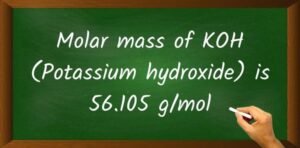KOH Molar Mass Calculation

To calculate the molar mass of KOH (potassium hydroxide), we need to sum the atomic masses of its constituent elements: potassium (K), oxygen (O), and hydrogen (H). The atomic masses of these elements can be found on the periodic table.
The atomic mass of potassium (K) is approximately 39.09 g/mol. The atomic mass of oxygen (O) is approximately 16.00 g/mol. The atomic mass of hydrogen (H) is approximately 1.01 g/mol.
Using these values, we can calculate the molar mass of KOH as follows:
Molar mass of KOH = atomic mass of K + atomic mass of O + atomic mass of H Molar mass of KOH = 39.09 g/mol + 16.00 g/mol + 1.01 g/mol Molar mass of KOH = 56.10 g/mol
Therefore, the molar mass of KOH is approximately 56.10 grams per mole.
Understanding Molar Mass
Molar mass is a fundamental concept in chemistry that represents the mass of one mole of a substance. A mole is defined as 6.022 x 10^23 particles (atoms or molecules), and the molar mass is the mass of this many particles. It’s an essential value for calculating the amounts of substances involved in chemical reactions, and it’s crucial for determining the concentrations of solutions.
Importance of KOH
Potassium hydroxide (KOH) is a strong base that finds applications in various industries, including the manufacture of soap, glass, and paper. It’s also used in the production of biodiesel and as an electrolyte in alkaline batteries. Understanding its properties, including its molar mass, is vital for its safe handling and use in these applications.
Chemical Reactions Involving KOH
In chemical reactions, the molar mass of KOH is used to calculate the amounts of reactants and products. For example, when KOH reacts with hydrochloric acid (HCl) to form potassium chloride (KCl) and water (H2O), the balanced chemical equation is:
KOH + HCl -> KCl + H2O
To calculate the mass of KOH needed to react with a given amount of HCl, or to find out how much KCl is produced, the molar masses of all substances involved are necessary.
Calculation Examples
- Mass of KOH Needed to React with HCl: If you have 10 grams of HCl (with a molar mass of approximately 36.46 g/mol), how much KOH is needed for a complete reaction?
First, calculate the number of moles of HCl: moles of HCl = mass of HCl / molar mass of HCl = 10 g / 36.46 g/mol = approximately 0.274 mol
Since the reaction is 1:1, you need the same number of moles of KOH: moles of KOH = 0.274 mol
Then, calculate the mass of KOH needed: mass of KOH = moles of KOH * molar mass of KOH = 0.274 mol * 56.10 g/mol = approximately 15.38 g
- Production of KCl: From the reaction of 10 grams of HCl with excess KOH, how much KCl can be produced? The molar mass of KCl is approximately 74.55 g/mol.
Given that the number of moles of HCl is 0.274 mol, and assuming a complete reaction, the same number of moles of KCl will be produced: moles of KCl = 0.274 mol
Then, calculate the mass of KCl produced: mass of KCl = moles of KCl * molar mass of KCl = 0.274 mol * 74.55 g/mol = approximately 20.44 g
Conclusion
Calculating the molar mass of KOH is a straightforward process that involves summing the atomic masses of its constituent elements. This value is crucial for various applications, including the calculation of reactant and product amounts in chemical reactions. Understanding how to apply molar mass in different scenarios is fundamental to working with chemicals like KOH safely and effectively.
What is the molar mass of KOH?
+The molar mass of KOH (potassium hydroxide) is approximately 56.10 g/mol, calculated by summing the atomic masses of potassium (39.09 g/mol), oxygen (16.00 g/mol), and hydrogen (1.01 g/mol).
How is the molar mass of a compound calculated?
+The molar mass of a compound is calculated by summing the atomic masses of all the atoms in the chemical formula of the compound.
What are some industrial applications of KOH?
+KOH has various industrial applications, including the production of soap, glass, and paper, as well as the manufacture of biodiesel and its use as an electrolyte in alkaline batteries.
Why is molar mass important in chemistry?
+Molar mass is crucial for calculating the amounts of substances involved in chemical reactions, determining the concentrations of solutions, and understanding the properties of substances.
In conclusion, the calculation of the molar mass of KOH, and the understanding of how it applies to various scenarios, is a foundational aspect of chemistry with significant implications for both theoretical knowledge and practical applications across different industries.


